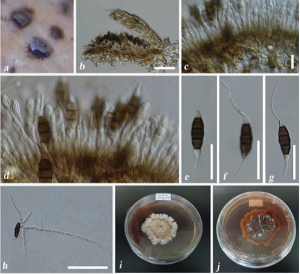Monochaetia ilicis N.I. de Silva, Phookamsak & K.D. Hyde [as ‘ilexae‘], in De Silva, Phookamsak, Maharachchikumbura, Thambugala, Bhat, Al-Sadi, Lumyong & Hyde, Phytotaxa 291(2): 126 (2017)
Index Fungorum number: IF 628851; MycoBank number: MB 628851; Facesoffungi number: FoF 11685;
Etymology – the epithet “ilexae” refers to the host, of which the taxon was collected.
Saprobic on dead leaves of Ilex sp. Sexual morph: Undetermined. Asexual morph: Conidiomata 115–180 μm diam, pycnidial, solitary, scattered, immersed to erumpent, easily broken, visible as brown, flat, scar-like structures on the host, uni-loculate, glabrous, without an ostiole, releasing conidia by breaking the host surface. Conidiomata wall multi-layered, thin walled, brown, comprising cells of textura angularis. Conidiophores indistinct. Conidiogenous cells 4–6 × 1–2 μm ( x̅ =5.4 × 1.4 μm), holoblastic, phialidic, discrete, cylindrical, hyaline, smooth, thin-walled. Conidia 20–27 × 3–5 μm diam. ( x̅ =23.7 × 6 μm), fusiform, tapering at both ends, 4-septate, erect or sometimes slightly curved; apical cell 2.5–4.7 μm long ( x̅ =3.7 μm), conical, hyaline and smooth-walled; three median cells together 13–18 μm long ( x̅ =15.8 μm), doliiform, brown, rough-walled, echinulate, upper second cell 4.9–7.1 μm long ( x̅ =5.7 μm), upper third cell 3.5–5.9 μm long ( x̅ =5.1 μm), upper fourth cell 4.3–6.9 μm long ( x̅=5.6 μm); basal cell 2.6–5.2 μm long ( x̅ =3.7 μm), conic, hyaline and smooth-walled; apical appendage 6–24 μm long ( x̅ =15.3 μm), single, tubular, filiform; basal appendage 3–12 μm long ( x̅ =7.3 μm), single, central, tubular, filiform.
Culture characteristics – Colonies on PDA 35 mm diameter after 7 days at 25 °C, circular, raised, dense surface with lobate edge, zonate with different sector light brown at the margin, brown at the center and; reverse brown at the margin, dark brown at the center.
Material examined – China, Yunnan Province, Shangri-La, on a dead leaf of Ilex sp. (Aquifeliaceae), July 2014, R. Phookamsak, NI009 (HKAS 92492, holotype, MFLU 16–1429 isotype), ex-type living culture KUMCC 15–0520, MFLUCC 16–0829.
Sequence data – ITS: OK339753 (ITS1/ITS4); LSU: OK339782 (LROR/LR5); tef1: OK358481 (EF1-728F/EF2); tub2: OK358490 (Bt2a/Bt2b)
Notes – The new strain, Monochaetia ilexae clusters with Monochaetia species, but is separated from the main clade with high bootstrap support (100% ML, 98% MP, 1.00 PP, Fig. 1). Monochaetia ilexae shares similar morphology with the type, M. monochaeta (Guba 1961) in having fusiform conidia and has a similar range of conidia (20–27 μm) with M. kansensis (18–26 μm) (Guba 1961). However, M. ilexae differs from M. monochaeta as the former has fusiform, brown, 20–27 μm long conidia with a 6–24 μm long, single, apical appendage, whereas M. monochaeta has pale olivaceous, 15–21 μm long conidia, with a 5–19 μm long, single, apical appendage (Guba 1961). Monochaetia kansensis differs in its erect, slightly curved, olivaceous or umber conidia, with a 10–38 μm long, single, apical appendage.

FIGURE 1. Monochaetia ilicis (HKAS 92492, holotype) a Conidiomata on the host. b, c Sections through conidiomata. d Conidia with conidiogenous cells. e–g Conidia. h Germinating spore. j Upper view of culture. k Lower view of culture. Scale bars: b, h = 50 μm, c = 10 μm, e–g = 20 μm.
